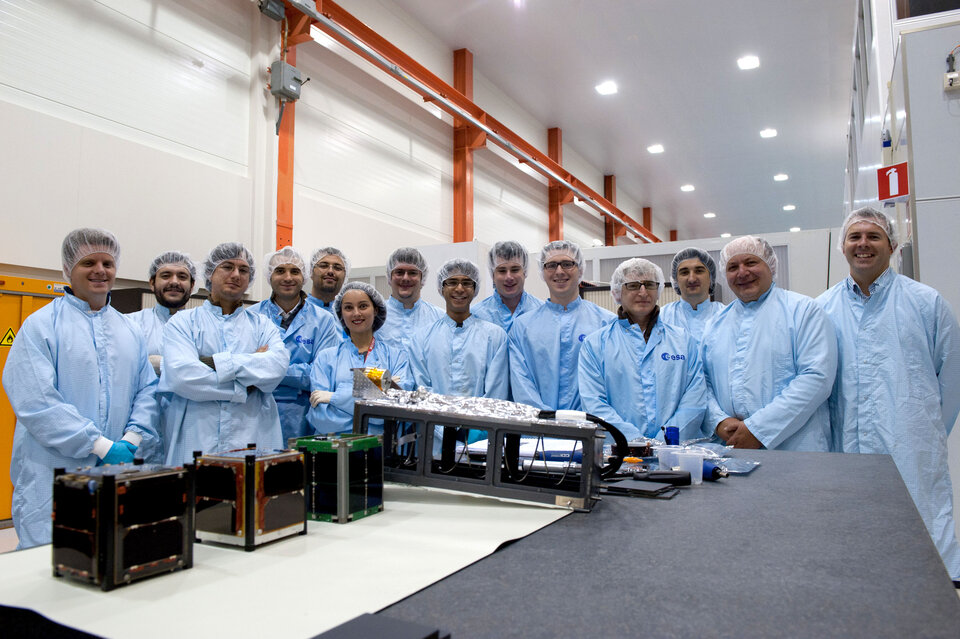Hyperspectral imaging by CubeSat on the way
A new hyperspectral camera able to fit in the palm of a hand, compact enough to fly on CubeSat-sized missions, is being developed by ESA.
Hyperspectral instruments divide up the light they receive into hundreds of very narrow, adjacent wavelengths to reveal ‘spectral signatures’ of particular features, crops or materials, providing valuable data for fields such as mineralogy, agricultural forecasting and environmental monitoring.
These cameras are typically bulky items of 100 kg or more, requiring costly full-sized satellites. But advanced electronics and new materials and methods are opening up new possibilities for miniaturising payloads.
ESA is now working on a hyperspectral instrument to be carried inside the CubeSat standard, meaning a 10 cm cube – a litre – weighing no more than 1.33 kg.

“We see this as working like a ‘little brother’ to full-sized hyperspectral imagers,” explains ESA’s Alessandro Zuccaro Marchi, overseeing the project.
“It won’t replace them, possessing lower spectral resolution and signal-to-noise ratio, but it could do some useful complementary work as a low-cost instrument of opportunity, added to standard satellite payloads or flown on its own aboard CubeSats.
The optics are based around a compact trio of precisely curved aluminium mirrors. Larger ‘Three Mirror Anastigmat’ telescopes are well known and already widely used for space applications.

“One of the advantages of this design is that none of the mirrors sits in front of the others, so there is no obscuring of light,” says Alessandro. “Furthermore, it is possible to obtain a wide field of view while maintaining an acceptable image quality.
“For this project, a 50° field of view coupled with good spatial resolution across hundreds of spectral bands means it would offer a useful overview or early warning capability, for potential follow-up by a larger instrument to acquire more detail.”
The major advance that allows shrinking these optics into a palm-sized design is the ‘single diamond point turning’ manufacturing technique.

“This already precise technique was improved and employed to mill the aluminium mirrors down to an accuracy of a few nanometres, a millionth of a millimetre,” adds Alessandro.
With the electronics coming off the shelf, the other crucial factor will be the development of data compression techniques to reduce the huge amount of information that the instrument can produce down to levels that are more easily handled by a miniature satellite’s limited communications for downlink to Earth.
To prove the technological feasibility, a prototype engineering model of the instrument’s telescope was built by Dutch company VDL ETG under ESA contract.
“The result was a sufficiently good optical quality that also has potential to be applied for hyperspectral imaging,” adds Alessandro.
“So our plan from here is to push the envelope and shrink the design even further. Together with the prototyping of novel data compression algorithms, this system has the potential to become very attractive.”
This next telescope will fit inside a single CubeSat unit, together with its electronics, a ‘disperser’ to split the light into wavelengths, plus electronic detectors, while the platform overseeing the satellite would be housed inside the other two units.
This project has been backed through ESA’s General Support Technology Programme, turning promising ideas into final hardware that is ready for spaceflight and the open market.
About CubeSats

CubeSats, a miniaturised satellite standard invented at the California State Polytechnic and Stanford University at the turn of the century, have made space missions affordable for individual university departments or small- to mid-sized companies.
Many CubeSats – whether single, double or triple versions – are flown annually, often with multiple CubeSats hitching a ride within dispensers on an individual rocket launch
ESA organises, together with France’s CNES space agency, a biennial conference on Small Satellites and CubeSats (dubbed the 4S Symposium), to gather all the principal companies, universities and research centres to promote this space sector.
A CubeSat Workshop runs in parallel to the main conference. The 2014 event will take place on Majorca Island in May.




